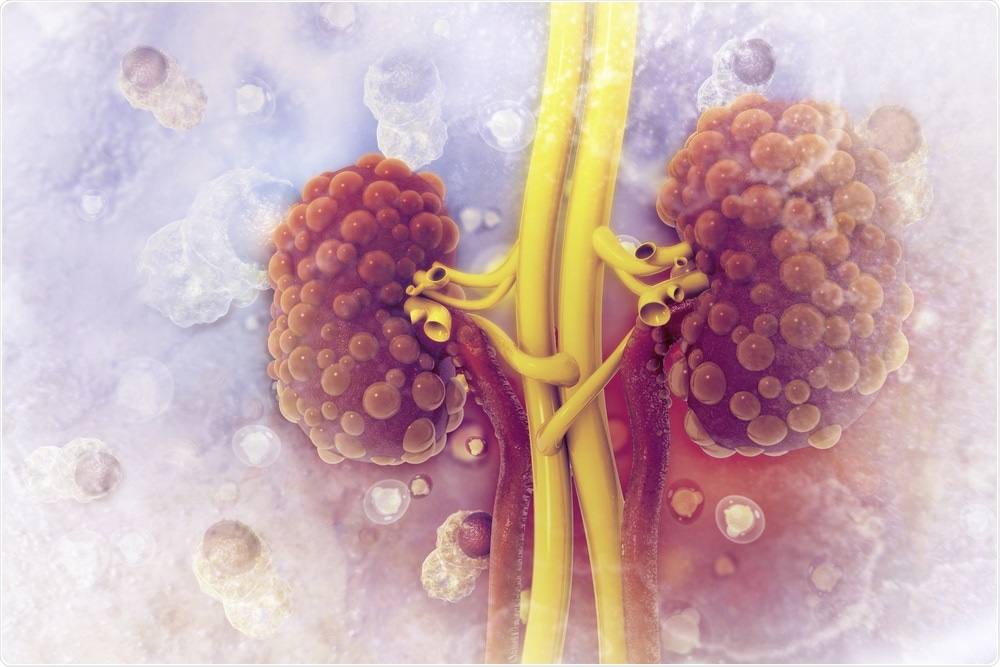Chronic kidney disease affects around 850 million individuals and is responsible for 1 in 60 deaths globally. Yet, not many treatments are available. A deeper knowledge of the genetic variations linked with the disease represents a vital step for drug development.

Kidney Disease. Image Credit: crystal light/Shutterstock.com
Recently, in one of the most extensive genome-wide association studies of its kind, scientists from the Perelman School of Medicine at the University of Pennsylvania pinpointed 182 genes likely responsible for kidney function—most of which can be targeted with existing drugs—and 88 genes for hypertension.
Moreover, the scientists mapped the key cell types and mechanisms that are associated with the disease. The results were published in the Nature Genetics journal.
The research offers one of the most comprehensible pictures to date of the genetic underpinnings of chronic kidney disease. It also opens the way for identifying possible treatments, which are critically needed, as per principal investigator Katalin Susztak, MD, Ph.D., a professor in the division of Renal-Electrolyte and Hypertension at Penn, who headed the study with lead author Xin Sheng, Ph.D., a postdoctoral fellow at Penn.
This is a key roadmap for understanding the mechanisms of chronic kidney disease. Fortunately, some of the genes we’ve identified for kidney disease can be targeted with existing drugs.”
Katalin Susztak, Professor, Renal-Electrolyte and Hypertension, University of Pennsylvania
Chronic kidney disease is an increasing global health problem and an economic burden. Total Medicare spending for patients with kidney failure attained $36.6 billion in 2018, accounting for around 7% of all Medicare-paid claims costs, as per the Centers for Disease Control and Prevention (CDC).
Despite diabetes and high blood pressure playing key roles in chronic kidney disease development, the disease has a strong heritable component, and genetic factors are progressively identified to contribute to disease risk.
To gain a better understanding of the genetic variations linked with kidney disease, scientists have focused on genome-wide association studies (GWAS), which includes scanning DNA variations across the complete genome in hundreds of thousands of individuals.
Prevalent genetic studies have discovered around 300 regions in the human genome that is linked with kidney disease; however, these maps have not been able to identify specific cell types, genes, and mechanisms.
The existing maps have indicated regions in the genome for kidney disease heritability, like an initial treasure map, but, until now, we did not know where the treasure chest was located or how it looked. Our goal was to find the exact location of the treasure and to open up the box to see what was inside.”
Katalin Susztak, Professor, Renal-Electrolyte and Hypertension, University of Pennsylvania
One major challenge in translating genetic maps to specific genes is that a majority of the genetic variants that can cause kidney disease to modify how the genes are regulated. To find a solution, scientists collected 659 human kidney samples—a huge population. After manually dissecting each tissue sample, they examined the expression of each gene and the genetic variation.
The researchers then generated gene expression and regulation data for each human kidney cell type by employing a newly devised single-cell sequencing process. This allowed the scientists to pinpoint the key cell types where the genetic variant induces a faulty expression of genes. The findings identified around 200 genes for kidney function and nearly 100 genes for hypertension.
The scientists finally explained the mechanisms behind several existing kidney disease drugs—including angiotensin-converting enzyme inhibitors and angiotensin receptor blockers—demonstrating that they matched with the genes involved in the disease.
We have used these drugs for several decades, but now we know why they work so effectively. This study represents a very important milestone for the nephrology field and the millions of patients currently affected by chronic kidney disease.”
Katalin Susztak, Professor, Renal-Electrolyte and Hypertension, University of Pennsylvania
Source:
Journal reference:
Sheng, X., et al. (2021) Mapping the genetic architecture of human traits to cell types in the kidney identifies mechanisms of disease and potential treatments. Nature Genetics. doi.org/10.1038/s41588-021-00909-9.